Dolphin watching tours in Southern Europe provide unique recreational opportunities while promoting wildlife conservation and environmental stewardship. This article explores responsible practices that protect marine ecosystems, highlights the impact of seasonal changes on dolphin behavior, and discusses the economic benefits for local communities. It also addresses the challenges tour operators face and offers guidelines for tourists to minimize their environmental impact.

What are the key benefits of dolphin watching tours in Southern Europe?
Dolphin watching tours in Southern Europe offer numerous benefits, including wildlife conservation, educational experiences, and unique recreational opportunities. These tours promote responsible practices that protect marine ecosystems. Tourists contribute to local economies and gain insights into dolphin behavior and habitats. Additionally, these experiences foster a greater appreciation for marine life, encouraging environmental stewardship.
How do dolphin watching tours contribute to marine conservation?
Dolphin watching tours contribute to marine conservation by promoting awareness and funding for protection efforts. These tours often support local research initiatives and encourage sustainable practices among tourists. As a result, they foster a deeper appreciation for marine ecosystems and the need for their preservation. Many operators implement responsible practices, such as limiting group sizes and adhering to guidelines that minimize disturbance to dolphins. This approach not only enhances the experience for visitors but also safeguards the natural habitat of the dolphins, ensuring their longevity in the wild.
What educational opportunities do these tours provide?
Dolphin watching tours in Southern Europe offer educational opportunities that enhance awareness of marine ecosystems. Participants learn about dolphin behavior, conservation efforts, and the ecological impact of tourism. These tours often include expert guides who provide insights into the importance of responsible practices in wildlife observation. As a result, tourists gain a deeper understanding of the need to protect marine environments while enjoying the experience.
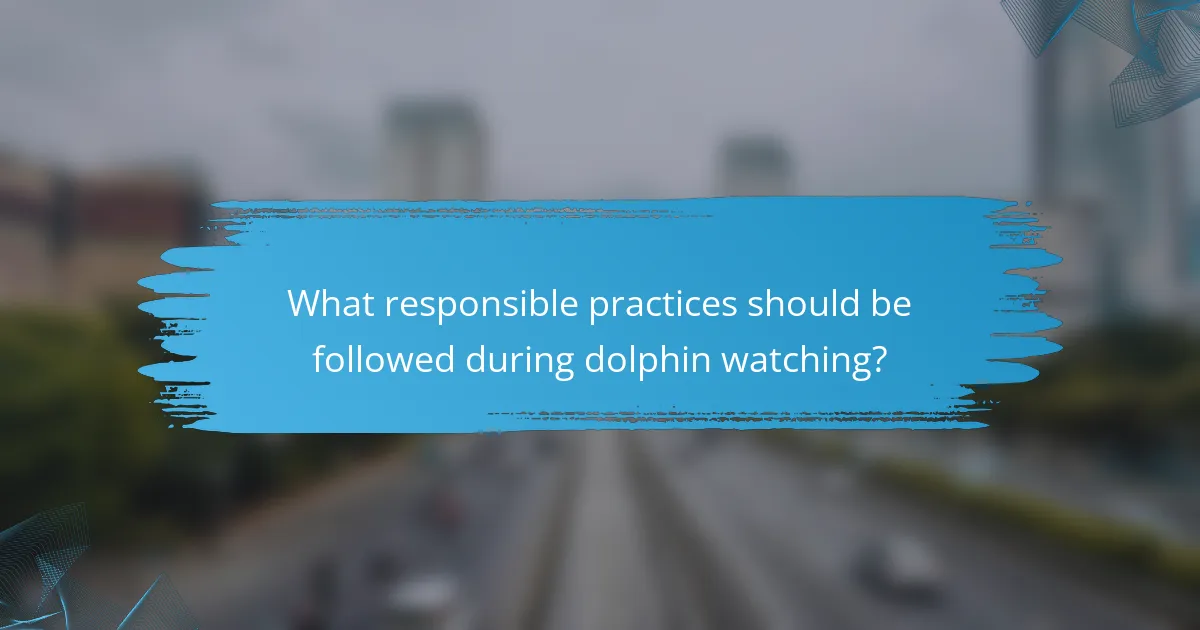
What responsible practices should be followed during dolphin watching?
Responsible dolphin watching practices prioritize the well-being of dolphins and their habitats. Tour operators should maintain a safe distance, avoid disrupting social behaviors, and limit the number of boats in an area. Educating participants about dolphin behavior and conservation is essential. Additionally, operators should follow local regulations and support marine conservation efforts.
How can tour operators minimize environmental impact?
Tour operators can minimize environmental impact by implementing sustainable practices. They can limit the number of boats in sensitive areas, ensuring minimal disturbance to marine life. Educating tourists on responsible behaviors fosters respect for the ecosystem. Collaborating with local conservation organizations enhances protection efforts. Regularly monitoring environmental conditions helps adapt practices to changing ecosystems.
What guidelines should tourists follow to ensure responsible viewing?
To ensure responsible viewing during dolphin watching tours, tourists should follow specific guidelines. Maintain a respectful distance from dolphins to avoid disturbing their natural behaviors. Avoid feeding or attempting to touch the dolphins, as this can disrupt their feeding habits and social structures. Choose eco-friendly tour operators that prioritize sustainability and adhere to local regulations. Educate yourself about dolphin behavior and habitats to enhance your understanding and appreciation. Lastly, report any illegal or harmful practices to authorities to protect marine wildlife.
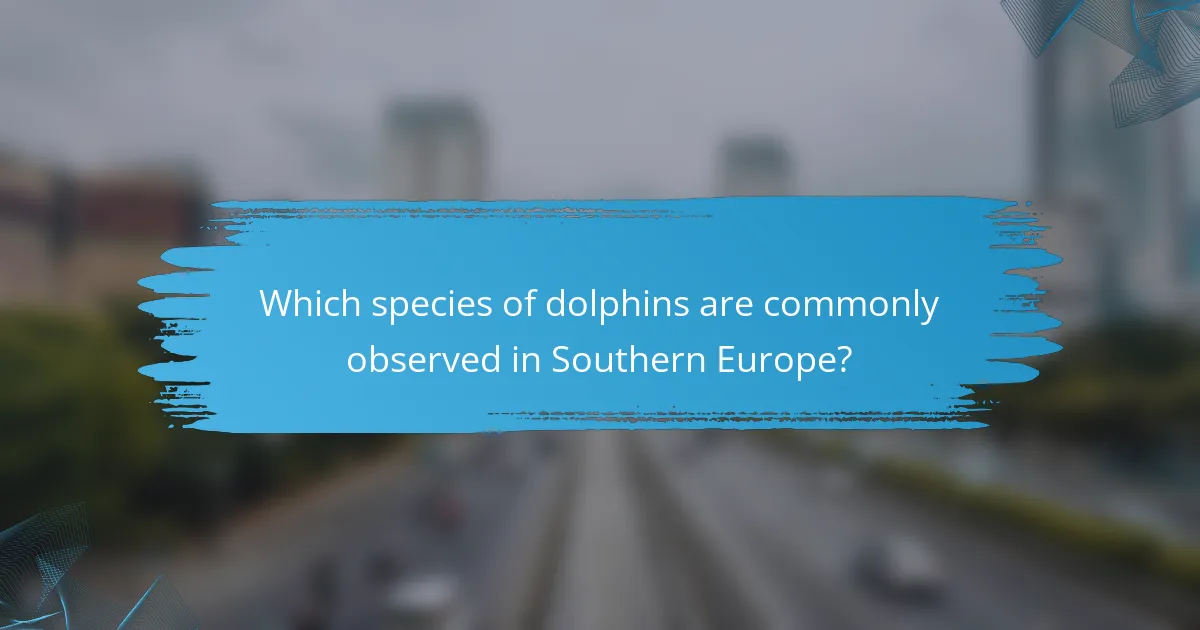
Which species of dolphins are commonly observed in Southern Europe?
Commonly observed dolphin species in Southern Europe include the bottlenose dolphin and the common dolphin. These species thrive in the Mediterranean Sea and are frequently seen during dolphin watching tours. Bottlenose dolphins are known for their intelligence and playful behavior, while common dolphins are recognized for their acrobatic displays. Conservation efforts are essential to protect these species and their habitats from environmental threats.
What unique behaviors can be expected from different dolphin species?
Different dolphin species exhibit unique behaviors that enhance the dolphin watching experience. For instance, bottlenose dolphins are known for their acrobatics and social interactions, often seen leaping and riding waves. Common dolphins display high-speed swimming and coordinated group movements, which can be mesmerizing to observe. Spinner dolphins are famous for their spinning leaps, adding a playful element to tours. Additionally, orcas, though technically a dolphin species, exhibit complex social structures and hunting techniques, showcasing their intelligence. Understanding these behaviors enriches the experience of responsible dolphin watching in Southern Europe.
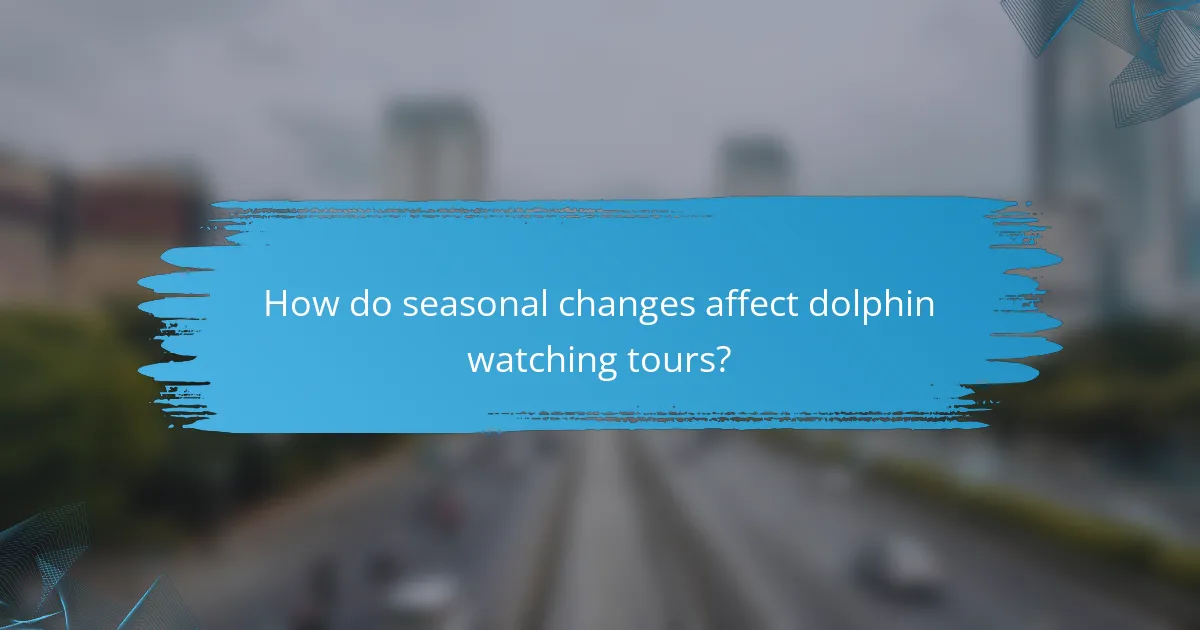
How do seasonal changes affect dolphin watching tours?
Seasonal changes significantly influence dolphin watching tours in Southern Europe. Weather patterns affect dolphin behavior and visibility, impacting tour schedules and experiences.
In spring and summer, warmer waters attract more dolphins, enhancing sighting opportunities. Conversely, autumn and winter may reduce dolphin activity due to cooler temperatures and migratory patterns. Tour operators adjust their practices to promote responsible viewing during these fluctuations, ensuring minimal disturbance to marine life.
Additionally, environmental factors like water clarity and food availability fluctuate with seasons, which can alter dolphin distribution. Understanding these dynamics helps improve the sustainability of dolphin watching tours while maximizing enjoyment for participants.
What are the best times of year for dolphin sightings?
The best times for dolphin sightings in Southern Europe are during the warmer months, particularly from May to September. This period offers optimal weather conditions and increased dolphin activity. During these months, dolphins are often seen in larger groups, making it ideal for watching tours. Additionally, the clear waters enhance visibility, improving the overall experience for participants. Responsible dolphin watching practices are crucial during this time to minimize environmental impact and ensure the well-being of the dolphins.
How do weather conditions influence tour experiences?
Weather conditions significantly influence dolphin watching tours by affecting dolphin behavior and tour safety. Factors like temperature, wind, and sea conditions determine visibility and the likelihood of dolphin sightings. For example, calmer seas enhance the experience, while storms may lead to cancellations. Seasonal variations also impact dolphin migration patterns, influencing the best times for tours. Overall, favorable weather enhances both the enjoyment and environmental responsibility of these tours.
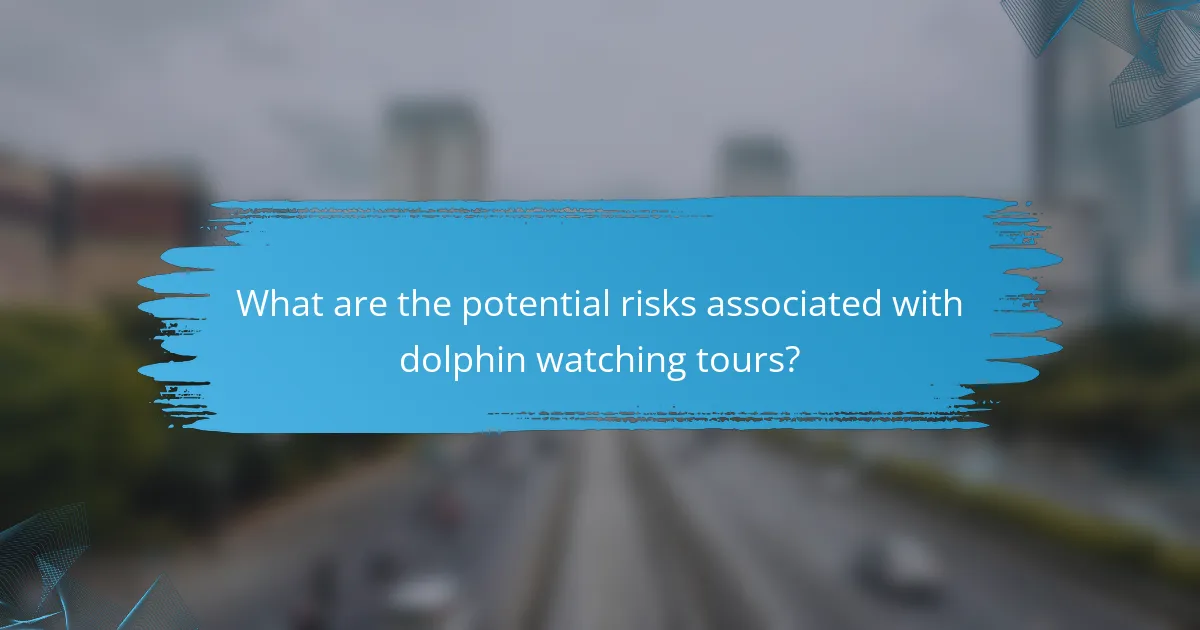
What are the potential risks associated with dolphin watching tours?
Dolphin watching tours can pose risks such as disturbance to marine life, habitat degradation, and potential injury to both dolphins and humans. Excessive boat traffic may disrupt dolphins’ natural behaviors, leading to stress and displacement. Additionally, improper tour practices can result in environmental pollution. Responsible operators should prioritize conservation to mitigate these impacts.
How can tour operators mitigate safety concerns for both dolphins and tourists?
Tour operators can mitigate safety concerns for dolphins and tourists by implementing strict guidelines and best practices. These include maintaining safe distances from marine life, providing thorough training for staff, and ensuring compliance with environmental regulations.
Regular monitoring of dolphin behavior helps operators adjust tour routes to minimize stress on the animals. Educating tourists about responsible viewing practices fosters respect for wildlife. Additionally, using eco-friendly boats reduces noise pollution and environmental impact, promoting a safer experience for both dolphins and visitors.

What are the economic impacts of dolphin watching tourism in Southern Europe?
Dolphin watching tourism in Southern Europe significantly boosts local economies. It generates revenue through tours, creates jobs, and supports conservation efforts. For instance, a study indicated that this sector can contribute over €100 million annually to coastal communities. Additionally, responsible practices enhance the sustainability of marine ecosystems, ensuring long-term economic benefits.
How does local community involvement enhance tour sustainability?
Local community involvement significantly enhances tour sustainability by fostering environmental stewardship and promoting cultural awareness. Engaging local stakeholders ensures that dolphin watching tours align with conservation efforts, preserving marine habitats and wildlife. Community members can offer insights into sustainable practices, improving tour operations and reducing environmental impact. This collaboration often leads to increased visitor satisfaction, as tourists appreciate authentic experiences that support local economies and conservation initiatives. Ultimately, when communities actively participate, they create a more sustainable framework for dolphin watching tours in Southern Europe.
What role do regulations play in shaping the industry?
Regulations play a crucial role in shaping dolphin watching tours by ensuring responsible practices and minimizing environmental impact. They establish guidelines that protect marine life and promote sustainable tourism. For example, regulations often limit the number of boats allowed in specific areas, reducing noise pollution and disturbances to dolphins. Compliance with these rules fosters a healthier ecosystem and enhances the overall experience for tourists. Additionally, regulations can enforce educational programs for tour operators, emphasizing the importance of conservation and ethical interactions with wildlife.
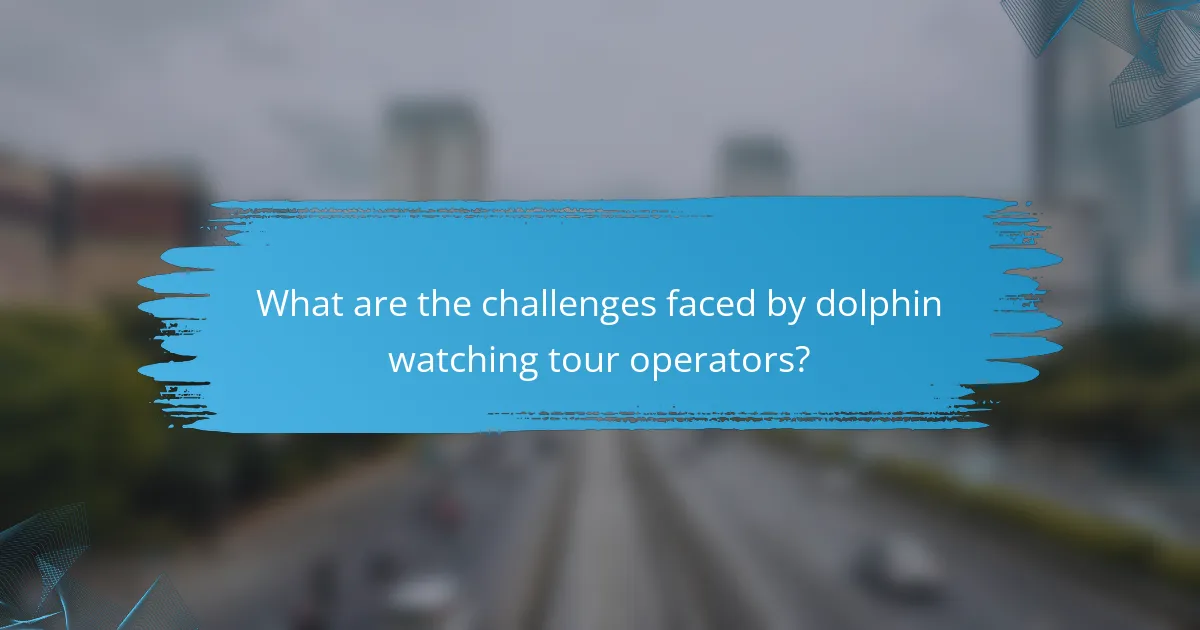
What are the challenges faced by dolphin watching tour operators?
Dolphin watching tour operators face several challenges that impact their operations and sustainability. Key issues include environmental regulations, competition, and the need for responsible practices.
Regulatory compliance is crucial as operators must adhere to strict environmental laws aimed at protecting marine life. This can limit tour options and require ongoing training for staff.
Competition from other tour operators can drive prices down, affecting profitability. Operators must differentiate their services by emphasizing responsible practices and unique experiences.
Additionally, environmental impacts such as pollution and climate change threaten dolphin habitats, making sustainable practices essential for long-term viability. Tour operators must actively engage in conservation efforts to mitigate these impacts.
How do changing regulations impact tour operations?
Changing regulations significantly impact dolphin watching tours in Southern Europe by enforcing stricter environmental standards. These regulations aim to protect marine life and promote responsible tourism practices. As a result, operators must adapt their methods to comply, ensuring minimal disturbance to dolphin habitats. Compliance can enhance the sustainability of tours, attracting environmentally conscious tourists. Additionally, regulations may require training for staff on responsible practices, further elevating the quality of the tours offered.
What strategies can operators implement to overcome environmental challenges?
Operators can implement several strategies to overcome environmental challenges in dolphin watching tours. These include adopting eco-friendly practices, educating tourists on marine conservation, and collaborating with local conservation organizations.
1. Implement strict guidelines for boat speeds to minimize disturbances to marine life.
2. Limit the number of boats in sensitive areas to reduce overcrowding.
3. Use sustainable materials for tour equipment and promotional materials.
4. Train guides to provide accurate information about dolphin behavior and habitats.
5. Promote responsible viewing distances to avoid stress on the animals.
6. Engage in ongoing monitoring of dolphin populations and marine health.
These strategies not only protect marine ecosystems but also enhance the overall experience for tourists.

What are the best practices for tourists participating in dolphin watching tours?
To ensure a positive experience while minimizing environmental impact, tourists should follow responsible practices during dolphin watching tours. Respect wildlife by maintaining a safe distance, avoiding loud noises, and never feeding the dolphins. Choose eco-friendly tour operators that prioritize conservation efforts and adhere to local regulations. Educate yourself about dolphin behavior and ecosystems to appreciate the experience fully. Lastly, consider the time of day for optimal viewing, as dolphins are more active during certain hours.
How can tourists ensure a positive experience for themselves and the dolphins?
Tourists can ensure a positive experience for themselves and the dolphins by following responsible practices. Prioritize eco-friendly tour operators that adhere to guidelines protecting marine life. Maintain a respectful distance from dolphins to avoid stressing them. Avoid feeding or attempting to touch dolphins, as this disrupts their natural behavior. Educate yourself about local dolphin species and their habitats to foster appreciation. Lastly, participate in conservation efforts to support sustainable tourism and protect marine ecosystems.
What common mistakes should be avoided during dolphin watching?
To enhance dolphin watching experiences, avoid common mistakes that harm marine life and the environment. Prioritize respecting wildlife, maintaining safe distances, and minimizing noise pollution.
1. Ignoring guidelines on distance from dolphins can stress them and disrupt their natural behavior.
2. Feeding dolphins or attempting to touch them can lead to dependency and health issues.
3. Overcrowding boats near dolphin pods can create disturbances and limit their space.
4. Failing to dispose of waste properly can pollute marine habitats and harm wildlife.
5. Not choosing eco-friendly tour operators can contribute to environmental degradation.
By adhering to responsible practices, you can enjoy dolphin watching while protecting these magnificent creatures and their ecosystem.